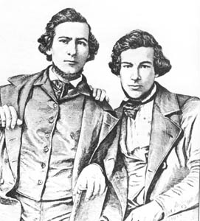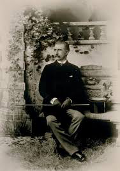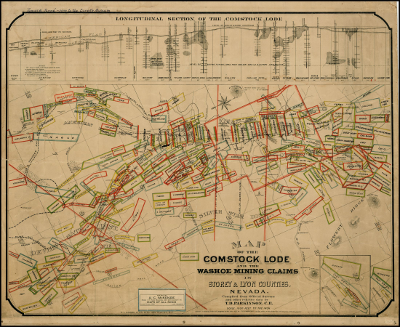The Comstock Lode
The Comstock Lode was the largest silver discovery in the United States. Nevada's Washoe Valley was home to a large number of mines, miners, and mining companies–all changing a dream of riches that few would see. 
A group of Mormon immigrants on their way further west stopped in 1850 near what is now Dayton, Nev., on the Carson River They arrived too late n the year to cross the Sierra Nevada and so camped for the winter. They found a bit of gold but left when the snow melted because the promise of much more gold was said to be in the offing in California. Word spread of the initial gold discovery in what came to be called Gold Canyon, and more prospectors arrived. More people found more gold, and mining continued for several years. 
It was in 1857 that the first silver was discovered. A pair of brothers, Ethan and Hosea Grosh, had mineralogy training and had worked the goldfields in California. They struck it rich but then needed more financing to find more silver. To raise money, they headed back to California, leaving their secrets in a locked chest and their interests in the hands of a friend and associate, Henry T. Comstock. Both Grosh brothers died before returning, and Comstock took the mining interests for himself. 
Comstock didn't know the location of what the Grosh brothers had found, but he did locate it eventually, thanks to the efforts of two other miners, Patrick McLaughlin and Peter O'Riley, who had found the beginnings of what became the Ophir bonanza and had agreed (some accounts say under duress) to share their find with Comstock. Thus is the Comstock Lode named after Henry Comstock. However, he was not the most successful of those who found precious metals or invested in their discovery and production. The amount of silver discovered in Nevada was large, but a large amount of gold was also discovered. The percentage of silver found in the Comstock Lode was 57; a full 42 percent was gold. (The remaining 1 percent was a host of trace amounts of other metals.) The combination of gold and silver made the find attractive to miners and prospectors and very attractive to investors. 
One particularly successful minder was John William Mackay (right), who came from California in 1859, struck it rich, and maintained his wealth for quite awhile. An Irishman by birth, Mackay formed a business partnership with Irishmen James Flood, James Fair, and William O'Brien; together, their Consolidated Virginia and California Mine found the richest ore in Comstock country in 1873. In the decade following that discovery, their one mine produced half of all silver produced in the U.S. at the time. Another very successful miner was James Vinney, who discovered gold in what came to be called Gold Hill. That location spawned the trappings of a growing settlement, along with places like Silver City and Virginia City, the latter of which was the unofficial capital of the mining community for several years. Also famous for wealth gained through investing in Comstock production was George Hearst, who had made his money in California originally and who invested in the company that owned and operated the Ophir mine. Hearst, a member of the California Assembly and the U.S. Senate, was the father of famed newspaper publisher William Randolph Hearst. Estimates are that miners pried $50 million worth of gold and silver ore from Comstock Lode territory in just the first six years of procurement; however, lengthy legal battles ensued during this period as well, and the figure often quoted to cover all of that is $10 million. 
The decade from 1865 to 1875 was marked by the participation of bankers, primarily from San Francisco. The Bank of California, led by Virginia City representative William Sharon, got into the Comstock market in a big way, offering loans at a very cheap rate of interest, snapping up customers that way, and then foreclosing on defaulting debtors by seizing claims, mines, and other parts of the process. Bankers also bought a regional railroad, the Virginia and Truckee Railroad, and used it to transport precious metals and mining equipment and personnel back and forth; the bank even created or acquired water and freight companies. The Transcontinental Railroad had arrived in 1869; before that, transportation of goods, supplies, machinery, and gold and silver was done using carts and wagons drawn by horses or mules. Next page > Money and Innovations > Page 1, 2 |
|
Social Studies for Kids
copyright 2002–2026
David White




